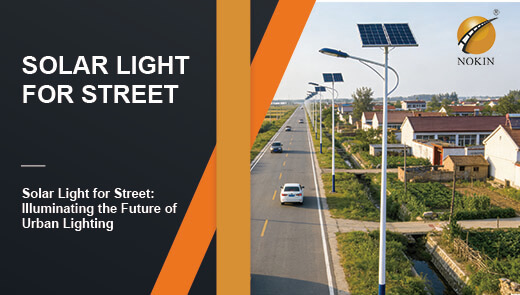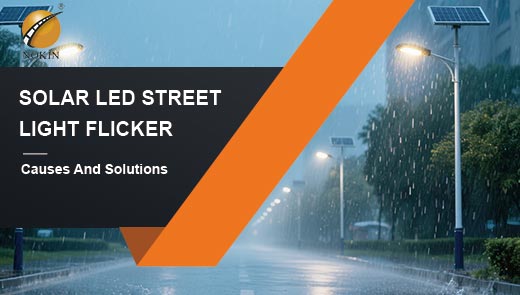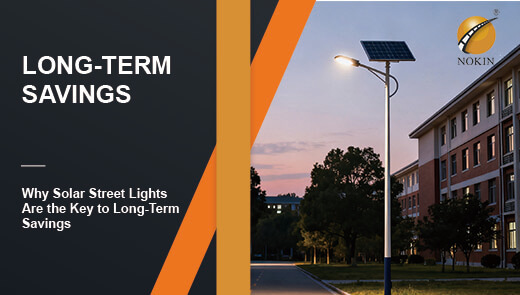How to Extend the Battery Life of Solar Street Light?
In a solar street light system, the battery is by no means a simple energy storage component; rather, it is the core that determines the availability of the entire equipment. During the day, solar panels convert light energy into electrical energy and store it in batteries. At night or on cloudy days, the battery powers the LED light source to ensure that the lighting is not interrupted.
However, when most users choose or maintain solar street lights, they often pay more attention to the power of the panel and the brightness of the LED, but neglect the importance of battery life. In fact, the rate of battery degradation directly affects the operational stability of street lights - a too short lifespan can lead to problems such as "bright on sunny days and dim on cloudy days" and "frequent power outages after just one year of installation", and it will also increase replacement costs and maintenance workload.
Next, NOKIN will provide a set of practical solutions from three dimensions: the influencing factors of battery life, practical extension techniques, and battery selection methods, to help users maximize the service life of solar street light batteries and reduce long-term investment costs.
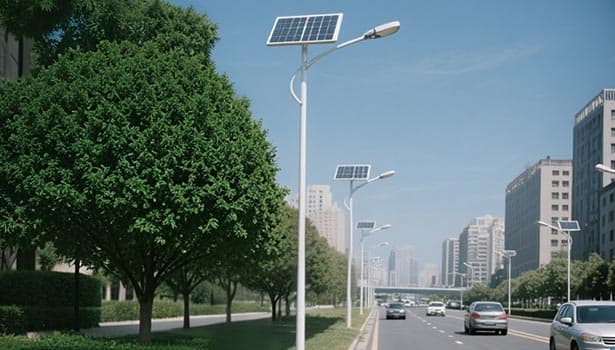
The Importance of Solar Street Lights Battery Life
Ensure the Lighting Reliability of Solar Street Lights
The core advantage of solar street lights is that they are "independent of power supply from the grid", and this advantage is entirely dependent on the energy storage capacity of batteries. Whether it is continuous rainy weather or the shortened daylight hours in winter, only batteries with a healthy lifespan can store sufficient electricity to ensure that street lights remain lit for the set duration (such as 10 to 12 hours), avoiding the impact of "nighttime light cut-off" on road safety or the use of public areas.
If the battery life deteriorates too quickly, it may lead to the situation where "it cannot be fully charged during the day and goes out after only two hours of use at night", making the solar street light become a "decoration" and lose its due functional value.
Determine the Cost Performance of the Solar Street Light System
From the perspective of cost structure, the battery replacement cost of solar street lights accounts for more than 60% of the total operation and maintenance cost. Take a conventional 30W solar street light as an example: lead-acid batteries need to be replaced every 2 to 5 years. If the service life can be extended by 1 to 2 years through maintenance, a single set of equipment can be replaced 1 to 2 times within 10 years, directly saving replacement costs.
At the same time, the degradation of battery life will "drag down" other components - if the battery is in a state of "not fully charged and not fully discharged" for a long time, it will lead to the inability to fully utilize the power generation efficiency of the solar panel, and the controller will frequently be in protection mode, indirectly shortening the service life of the entire system.
4 Factors Affecting the Solar Street Lights Batteries Lifespan
Battery Type
Different types of solar street light batteries have essential differences in terms of lifespan, cost and maintenance requirements. When choosing, it is necessary to weigh the usage scenarios. The specific differences are shown in the following table:
|
Battery Type |
Service Life (Years) |
Core Features |
Applicable Scenarios |
|
Lead-acid Battery |
2–5 |
Low cost and mature technology; requires regular water replenishment; poor heat resistance. |
Suitable for scenarios with limited budgets and high maintenance frequency, such as rural roads. |
|
Lithium-ion Battery (LiFePO₄) |
5–10 |
Long lifespan and high energy storage efficiency (around 90%); maintenance-free; wide temperature resistance range. |
Ideal for scenarios requiring high reliability and low maintenance costs, such as urban main roads and parks. |
|
Gel Battery (Sealed Lead-acid) |
4–6 |
Good sealing and vibration resistance; poor low-temperature performance; capacity declines with long-term use. |
Suitable for scenarios with frequent rain and vibration but stable temperatures, such as suburban auxiliary roads. |
Battery Capacity
Battery capacity is not necessarily "the larger, the better", but needs to be precisely matched with the power of street lights, operating time and backup requirements. If the capacity is too small, it will lead to "full during the day and completely discharged at night", and long-term deep discharge will accelerate the attenuation. If the capacity is too large and the battery remains in a "half-full state" for a long time, "sulfation" will occur, which will also shorten its lifespan.
For instance, a set of 40W LED solar street lights needs to provide 12 hours of night lighting and reserve two days of overcast days as a backup. According to the formula "Capacity (Wh) = Power (W) × Operating Duration (h) × standby Days × Loss factor (1.2)", it is calculated that at least 1440Wh of capacity is required (40W×12h×2 days ×1.2=1440Wh). Choosing a battery of this capacity can not only avoid deep discharge but also make full use of the energy storage space and reduce idle losses.
Charge and Discharge Cycle
The number of charge and discharge cycles of a battery is fixed - each time a "daytime charge → nighttime discharge" is completed, the capacity will slightly decline (usually 0.05%-0.1% each time). Under normal circumstances, the cycle life of lead-acid batteries is approximately 300 to 500 times, while that of LiFePO4 batteries is about 2,000 to 3,000 times.
However, "over-charging and over-discharging" will significantly accelerate attenuation:
- Overcharging: If the controller malfunctions and the battery continues to charge beyond the rated voltage (for example, charging a 12V battery to above 15V), it will cause the electrolyte to decompose, the casing to bulge, and the lifespan will be directly shortened by more than 50%.
- Deep discharge: If the battery is discharged to below 50% of its rated voltage (for example, a 12V battery is discharged to below 6V), it will cause sulfation of the plates and irreversibly reduce the capacity.
Environmental Conditions
Solar street lights are mostly installed outdoors. High temperature, low temperature, high humidity and dusty environments will directly affect the battery life.
- High temperature (> 40℃) : It will accelerate the chemical reactions inside the battery, causing the electrolyte to evaporate and the plates to corrode. For instance, in high-temperature regions such as Arizona, the lifespan of lead-acid batteries may be shortened from 5 years to 3 years.
- Low temperature (< -10℃) : It will reduce the ionic activity of the battery, decrease the charging efficiency, and long-term low-temperature charging will lead to "incomplete charging", indirectly increasing the cycle loss.
- High humidity/salt spray: In coastal areas such as Florida, humid air and salt spray can corrode battery terminals, leading to poor contact, increased power consumption and loss, and accelerating the aging of the casing.
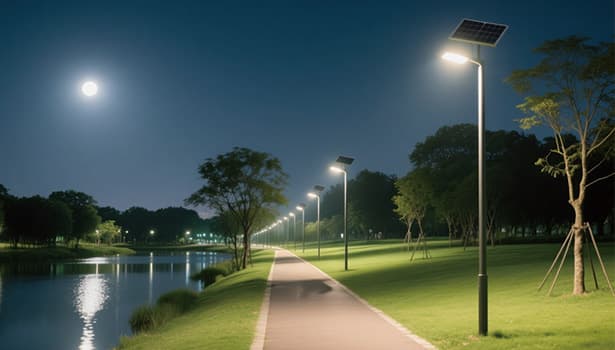
5 Tips for Extending the Solar Street Lights Battery Life
Clean the Solar Panels Regularly
The cleanliness of solar panels directly affects power generation. If the surface of the panels is covered with dust, bird droppings or fallen leaves, it will cause the power generation efficiency to drop by more than 30%. The batteries will remain "uncharged" for a long time and can only maintain lighting through deep discharge, accelerating the decline.
|
Item |
Specific Description |
|
Cleaning Frequency |
Clean once every 2–3 months in ordinary areas; for areas with heavy dust or bird droppings (such as industrial zones and parks), clean once a month. |
|
Cleaning Tools |
Use a soft cotton cloth or sponge with clean water; avoid abrasive tools such as steel wool or sandpaper to prevent scratching the panel coating and reducing light transmittance. |
|
Cleaning Time |
Perform cleaning in the early morning or evening when the panel temperature is below 30°C; avoid glass cracking caused by cold water contact on high-temperature panels. |
|
Upgrade Suggestion |
In dusty areas, consider upgrading to a "hydrophobic coating self-cleaning panel" that allows rainwater to automatically wash away dust, reducing manual cleaning frequency. |
Check the Battery on Time
Check frequency
A comprehensive inspection should be conducted every six months, and in harsh environments (high temperatures, coastal areas), it should be carried out every three months.
Core indicators
Measure the battery voltage with a multimeter - for a 12V system, the battery voltage should be maintained at 12.0V-13.5V (when fully charged). If it is lower than 11.5V, it indicates that the capacity has declined by more than 20%.
Protective measures
Install an intelligent controller with "overcharge/overdischarge protection". When the battery voltage exceeds 14.5V (overcharge) or drops below 10.5V (overdischarge), the circuit will be automatically cut off to protect the battery.
Change the timing
If lead-acid batteries show symptoms such as "rapid voltage drop after charging" or "a reduction of more than 20% in night lighting duration" after 2 to 3 years of use, they should be replaced in a timely manner. If the capacity of a LiFePO4 battery drops below 60% of its initial value after 5 to 6 years of use, it is recommended to replace it.
Check the Solar Street Light Wiring and Connection
Loose and corroded lines can lead to increased resistance, causing power loss. The electrical energy that should have been stored in the battery will be wasted due to line loss, and the battery can only "discharge more" to make up for it, indirectly increasing the cycle burden.
|
Item |
Specific Description |
|
Inspection Cycle |
Conduct a comprehensive line inspection once a year; perform an additional inspection after extreme weather conditions such as heavy rain or typhoons. |
|
Key Inspection Points |
- Check for corrosion on terminal blocks (green or white powder). If present, sand clean and apply anti-rust grease.- Inspect whether the circuit insulation layer is damaged to prevent short circuits.- Ensure that the connection lines between the battery compartment and the controller are firm to avoid loosening caused by vibration. |
|
Waterproof Requirement |
All connection parts should use waterproof connectors rated IP67 or above to prevent water ingress and short circuits. |
Optimize the Solar Street Lights Lighting Settings
Most solar street lights default to "full power on for 12 hours", but in actual scenarios (such as suburban roads and industrial parks), after 10 p.m., the flow of people and vehicles decreases, and full power on will cause waste of electricity and increase the pressure on battery discharge.
- Brightness adjustment: By setting "segmented dimming" through the intelligent controller, such as full power (100% brightness) from 18:00 to 22:00 and half power (50% brightness) from 22:00 to 6:00, the power consumption can be reduced by more than 30%.
- Timed switch: Adjust the lighting duration according to the season (such as 18:30-6:00 in summer and 17:00-7:00 in winter) to avoid "ineffective lighting".
- Environmental protection: In areas with frequent lightning, install lightning arrestors to prevent the controller and battery from being damaged by lightning strikes; In rainy areas, make sure there are drainage holes at the bottom of the battery compartment to prevent water accumulation from causing battery short circuits.
Remove Obstructions
Shadow is the "archenemy" of solar panels - even if only 10% of the panel area is covered by shadow (such as branches or billboards blocking the view), the power generation efficiency will drop by more than 50%, and the battery will be in a state of "undercharging" for a long time, naturally shortening its lifespan.
- Regular inspection: Inspect the surrounding environment of the panel once every quarter, promptly remove newly grown branches and weeds, or remove any newly added obstructions.
- Installation location: If there are tall trees around the street light, when installing, ensure that the distance between the panel and the trees is no less than 1.5 times the height of the trees to avoid the branches still blocking the sunlight after the leaves fall in winter.
- Angle adjustment: Adjust the panel's tilt Angle according to the local latitude to maximize sunlight reception and enhance charging efficiency.
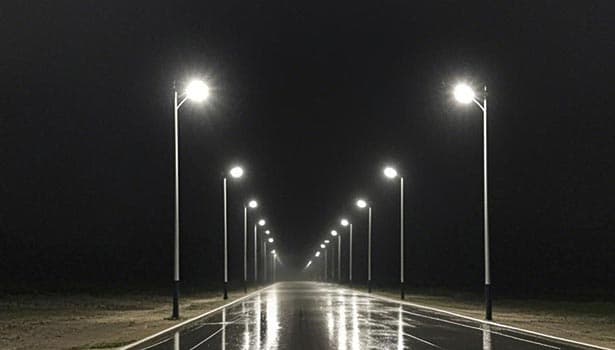
How to Choose the Right Solar Street Light Battery?
4 Indicators Determine the Solar Street Light Battery Quality
|
Category |
Key Requirement |
Example Explanation |
|
Battery Type |
LiFePO₄ batteries are preferred for their long lifespan and low maintenance. |
Suitable for main urban roads; lifespan 5–10 years; maintenance-free. Ideal for rural roads with limited budgets. |
|
Capacity Calculation |
Formula: Power × Duration × Standby Days × 1.2. |
Example: 40W × 12h × 2d × 1.2 = 1440Wh required capacity. |
|
Weather Resistance |
Protection level: IP65 or above; temperature range: -20°C to 60°C. |
Use IP67 waterproof batteries in coastal areas; low-temperature rechargeable batteries (-30°C) in northern regions. |
|
Certification |
Must have UL, CE, and ISO certifications. |
Ensures safety and compliance; avoids swelling or leakage from inferior batteries. |
Customized Options for Different Regions
High-temperature areas
- Climate characteristics: In summer, the temperature often exceeds 40℃, with strong sunlight. Batteries are prone to accelerated degradation due to high temperatures.
- Key points for selection: Prioritize the use of "high-temperature resistant" LiFePO4 batteries. The casing should have a heat dissipation design to prevent direct sunlight from causing excessive internal temperature.
- Additional measures: Install sunshades in the battery compartment or choose a buried battery compartment (where the underground temperature is more stable).
Cold regions
- Climate characteristics: In winter, the temperature often drops below -10 ℃, causing a decline in battery charging efficiency and even leading to "inability to charge".
- Key selection: Choose "low-temperature charging type" batteries, such as LiFePO4 batteries with heating function, to ensure normal charging at -20 ℃.
- Additional measures: Wrap the battery compartment with thermal insulation cotton to reduce the impact of low temperatures on the battery.
Coastal areas
- Climate characteristics: High humidity and high salt spray, which can easily corrode the battery casing and terminal blocks.
- Key points for selection: Choose "anti-corrosion type" batteries, with 304 stainless steel for the casing, nickel-plated terminal blocks, and a protection level of ≥IP67.
- Additional measures: Regularly wipe the exterior of the battery compartment with fresh water to remove residual salt spray.
Cost-performance Trade-off
Many users choose lead-acid batteries for LiFePO4 batteries due to their high initial cost (about 2 to 3 times that of lead-acid batteries), but in the long run, LiFePO4 batteries offer better value for money: they are not only easier to maintain but also have a lower replacement frequency.
4 Signals Indicate that the Solar Street Light Battery Needs to Be Replaced
The Charging Capacity Has Dropped Significantly
When the battery is fully charged, the duration of night lighting is reduced by more than 20% compared to normal conditions - for instance, it used to light up for 12 hours, but now it can only light up for 9 hours, and on cloudy days, it can only light up for less than 5 hours. This indicates that the battery capacity has severely declined and is unable to store sufficient electricity.
Frequent Occurrences of "Premature Power Outages"
If the solar street light goes out before the set power-off time and still cannot be restored after restarting the controller - for example, if it is set to turn off at 6 o 'clock but goes out at 4 o 'clock, and there is no problem with the panel and the circuit after checking, it indicates that the battery can no longer discharge for the set time and needs to be replaced.
The Battery has Suffered Physical Damage
After opening the battery compartment, if the battery shows any of the following conditions, it should be replaced immediately to avoid potential safety hazards:
- Bulging and deformed casing (overcharging causes the electrolyte to decompose and produce gas);
- Leakage (electrolyte leakage can corrode the circuits and battery compartment);
The terminal blocks are severely corroded (covered with green powder and cannot be repaired by grinding).
Unstable Performance
The brightness of the solar street light fluctuates frequently (such as suddenly dropping from 100% to 50%). When measuring the battery voltage with a multimeter, it was found that the voltage dropped from 13V to below 10V in a short period of time - indicating that the internal resistance of the battery has increased, the discharge capacity is unstable, and it cannot provide continuous power supply. It needs to be replaced.
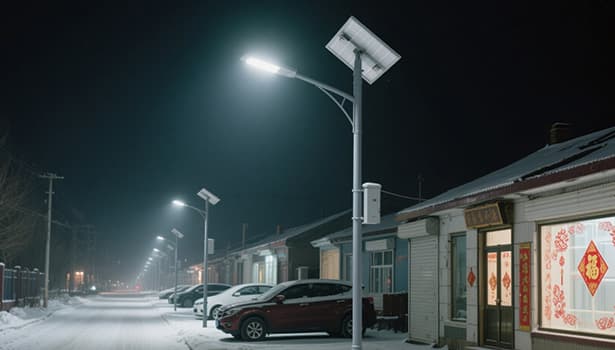
For users, extending battery life not only reduces operation and maintenance costs but also ensures the continuous and stable operation of solar street lights - whether it is urban main roads, park roads or rural paths, stable lighting is the foundation of safety. NOKIN hopes this article can help more users maximize the value of solar street lights and achieve "one-time investment, long-term benefits".

